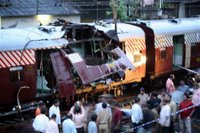
More than 160 people have died in the Indian city of Mumbai after a series of explosions in its railways system (one of the busiest in the planet). A few hours before, Chechen rebel Basayev (infamously nicknamed as the Beast of Beslan) was murdered by Russian special forces in the province of Ingushetia while the British Government decided to send 900 fresh troops to Afghanistan in an effort to counter recent waves of Taliban activity. All of this in one day. Three different occurrences “portraying” the troubled and contradicting times unfolding before us.
Take Ingushetia, Mumbai and Kabul, three sites distanced by 2500 km each, all have become interdependent stages where a single unique “play” is enacted – presenting 21st Century networked “schizowars”. Stepping away from the Clausewitzian wars of the 19th and 20th Century we seem to move towards multi-layered conflicts, underpinned by impairments in the perception and expression of different realities and by actors whose major asset is being dysfunctional. Dysfunctionality in a broad sense, as the key component of the soldier's psyche, providing him or her with invaluable flexibility, creativity and knack in its totalitarianism, in its fundamentalism.
The one key revolution in contemporary warfare confusing everyone is the primary radicalism of motif. In a perhaps unfair but viable hindsight exercise, one can contrast the conditions of post-modernity with the rational cool-bloodedness of old Cold War actors - combatant's have gone from being consequence-focused to being cause-focused. Motifs have undertaken the ends of war as primary, in simple terms, combatants fight less because they want to achieve a group's objective and more because of the personal dimensions of the motifs that have led them to take up arms. Like a young child whose solution to a problem is on the back of its mind superstitiously bound to arrive, the combatant's behaviour arises in a cone of reaction, an intense natural and artificial clash between the perceived spheres of the “good” and the sharp edges of the “bad”, instead of irrational wars with rational objectives we are left with an irrational grudge of unpredictably. A grudge that implodes again and again, attacking wannabe formatted realities.
One must find it mind-blowing to realise that in a sophisticated context of networked warfare never has the simplistic dichotomy between good and bad, right and wrong been more abrupt and more frequently used by both dimensions of the networks. We are not left with escalation but with painful repetition, a mad “deja vu” of screened visual narratives in a context of warped time and space – two spheres existing in a world of compressed time and space which are increasingly easier to manipulate by new technologies and by new uses to old ones, a world that on a day like today seems to be succumbing under the darkest sides of ideology and identity politics... Or was that just channel 4?
No comments:
Post a Comment